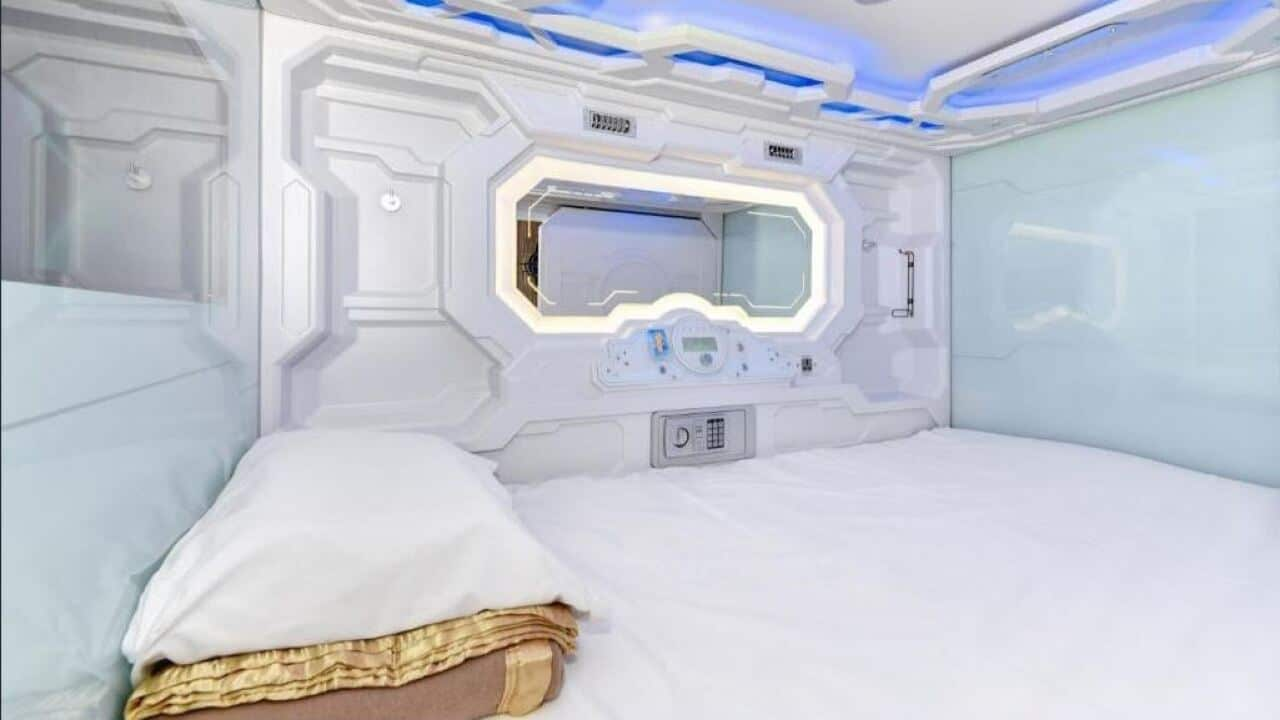Australia’s rental prices are soaring; so securing a place in the heart of the city for $250 a week might sound like a steal.
But if you want to move into this “unique accommodation solution” — as its listing agent describes it — you’ll almost certainly have to make some sacrifices.
The rental is not a small apartment or one-room studio, it’s a “capsule”: A small, cell-shaped room with just enough space for a mattress.
It’s located within a capsule hotel in the inner-Sydney suburb of Haymarket, and the online booking system suggests the property contains 98 single-bed and two double-bed capsules.
The listing says the building contains a communal kitchen, bathrooms, and a living room. Lockers are also provided for tenants.
The capsule is located at an inner-Sydney hotel that includes a communal kitchen, bathrooms, and a living room. Credit: Supplied/Screenshot
SBS News contacted the property manager responsible for the listing but he declined to comment.
The capsule was previously listed on property websites for $300 a week on a “long-term” basis, but has since been revised to $250 per week and “short-term”. Per calendar month, which is how rents are typically calculated, the revised price comes to about $1,086 a month.
It’s not the first time such property have appeared on Australia’s rental market.
In 2022, The Guardian reported a Melbourne landlord had added six “space shuttle” pod beds to his rental property in the inner-city suburb of Abbotsford. Each had a single mattress and features similar to the capsule advertised in Sydney, including a ventilation fan, USB ports, and a mirror.
The landlord told The Guardian that they were only intended for short-term rentals.
Sydney still holds the title for the capital city with the most expensive rents. Source: SBS News / Leon Wang
Where do capsule rooms come from?
Australia’s first capsule hotel opened in 2017 but the concept originated in Japan decades ago.
Japan’s first was built in Osaka in 1979 and aimed to address housing shortages for workers with long commutes.
Since then, capsule hotels have become a popular choice for anyone — Japanese and tourists alike — seeking an inexpensive and convenient bed for a night or two.
Yusuke Oba, a Sydney-based photographer who has lived in Australia for over 20 years, wanted to experience staying in a capsule hotel to better understand the culture of the country where he was born.
Yusuke Oba said capsule hotels are useful when getting home is a hassle or to keep costs down on a business trip. Credit: Supplied / Yusuke Oba
“You come across people of all ages and from all walks of life that you wouldn’t normally talk to,” he said.
“Hard-working office workers, blue-collar workers, travellers and students.”
The 46-year-old said Japan is a country built on trust, but he was still nervous when he stayed in a capsule hotel for the first time in May.
“I was a little worried about security and slept with my laptop and camera in my arms as the room was only partitioned off by a curtain,” he said.
Yusuke Oba recently stayed in a traditional capsule hotel above Tokyo’s Ueno train station. Credit: Screenshot/Ueno Station Hotel Oriental
Oba said the capsule was convenient for a business trip or travelling but couldn’t imagine living in one in Sydney’s CBD for $250 per week.
“It seems a bit expensive, and I don’t think it’s the kind of place I would use for a long-term,” he said.
Demand for singles accommodation
Andrea Sharam, senior lecturer at the School of Property Construction and Project Management at RMIT University was not surprised by the unique listing.
“It’s like a modern-day, much more upmarket version of a boarding house,” she said.
“There is a need for single accommodation, to be a single person and to try to afford an apartment, for example, is well beyond many people’s means now.”
The capsules are stacked on top of each other, with steps connecting the upper rooms to the floor. Credit: Supplied/Screenshot
In her view, long-term capsule living is an example of the market responding to demand.
“Housing affordability is declining in Australia; there is no prospect of that changing in the near future at all,” she said.
“So, we will see growing numbers of people occupying this type of accommodation or very similar types of accommodation.”
This story was produced in collaboration with SBS Japanese.





